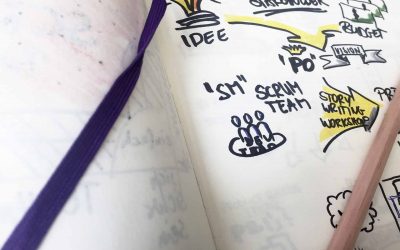A blog for people in organisations.
With useful, first-hand tips from experts.
The agile organisation of work in the craft sector
A baker organises himself agilely – sounds funny, but that’ s how it is. How can he improve the organisation of work, which is not yet perfect?
The discovery of sustainability
Sustainability is becoming more important for many companies. What is sustainability, what concepts and approaches are there for organisations?
The implementation of clean code
The principles and practices of professional software development are not enough to implement clean code. How can clean code be developed?
10 Characteristics of a Digital Mindset
What mindset is needed in the digital world and how do we educate our children so that they can survive and succeed the day after tomorrow?
Google Ranking Factors
What are the main Google ranking factors? Read backgrounds and a classification of important aspects and often repeated statements.
VUCA, so what?!
We live in a volatile, uncertain, complex and ambiguous world. What does it mean for companies and how can they succeed in the VUCA world?
I spy with my little eye: stakeholder
Although dealing with stakeholders is important for the success of organisations, it is often neglected. How does good stakeholder management work?
Cultural differences in projects
In international projects, cultural differences often have to be moderated. What does this mean for project implementation?
Jobs to be done …
“Jobs to be done” refers to the needs that a user really wants to meet with a product. How can the needs be determined in a workshop?
New Work and Old Work – An interview with Dr. Andreas Zeuch
Many organisations seeking better working concepts. An interview with Dr. Andreas Zeuch about the differences between New Work and Old Work.
Perfectionism and procrastination
Are you a perfectionist or prone to procrastination? What are the differences between the two tendencies and what can you do when in doubt?
Train soft skills by computer simulation
Personal and social competencies are becoming important for organisations. How can these soft skills be trained in a team using computer simulation?
With SCARF towards a more agile organisation
What is the SCARF model, on which principle is it based and how does it help in managing employees in the course of organisational change processes?
Agility begins with the heart
Many organisations try to become more agile, but the “Excellarator”, “Statusrititis” and “General” have something against it. Heart are needed here.
Argue – but do it right
Businesses waste valuable resources in conflicts when they focus on problems rather than solutions. How do you resolve conflicts?
Work agile or be agile
Agile living can be stressful for organisations because complex challenges require complex and original solutions. What should organizations do?
Advantages of Remote Work
Remote work offers several advantages for companies. What are these? How does Remote Work get started in organisations and does it work permanently?
Digital collaboration of distributed teams
When distributed teams work together, it is often difficult to know who is doing what, when, why and how. It’s time for a different approach.
Liberating Structures – Freedom for Better Communication
What is behind Liberating Structures (LS)? What is the benefit of LS, which mindset is necessary, which principles exist and what are advantages?
Digital Transformation – A Plea for Quality
The IT world is turning slower than expected. What is the reason for this, what awareness is important for companies and what should they value? A plea.
The agile label fraud
Many organisations call the project manager the Scrum Master, the product manager the Product Owner. Why isn’t that a good idea?
Conway’s one-way street
If a software architecture created in an organisation reproduces its structure, how does an adaptation of the organisation affect existing architectures?
Please don’t Uber yourself
Uber is a synonym for disruptive business models. Who can learn from it? How does benchmarking work and why does a comparison often make no sense?
Use Working Out Loud to develop competencies for agile work
What is Working Out Loud (WOL)? What are the core principles, what are WOL’s goals, and how can WOL be used to develop competencies for agile work?
Health as a strategic success factor in companies
How can companies operate in times with increasing demands for performance while paying real attention to the health of their employees?
The superfluous Scrum Master
The roles of Scrum Master and Product Owner are increasingly being merged in organisations. What are the reasons for this and what are the consequences?
Agile administration and local politics
Agility in public administration is gaining importance. How can agile methods enhance interaction between administration and politics? An impulse.
Agile requirements engineering
Does agile requirements engineering replace traditional RE? Where are the limits and where does the use of conventional techniques still make sense?
Recruiting competencies
The recruiting of many companies is biased and subjective. How can modern recruiting be successful and what competencies are important?
Is the world getting more complex?
There is a feeling that complexity is increasing in many areas. What impact does this have on decisions, project planning and the use of models?
Communication at work
There are many tips for communication in the workplace. However, there are many situations where attitudes and perspectives influence communication.
Fear and courage – two unequal siblings?
What are organisations afraid of? Do changes automatically trigger fears? And how can fear be overcome in both private and professional contexts?
Artificial intelligence and our future
Is artificial intelligence merely the continuation of a known development or will it revolutionise life as such? An opinion.
Learning coaching, but agile
Learning is individual, depending on prior knowledge, interest, and learning goals. This is where the agile learning coach and coaching come in.
Requirements Management with Jira and Confluence
How can Jira and Confluence be used for integrated requirements management? Which tool should be used for which tasks and what are the limits?
My wish list to Scrum Master
The Scrum Master is an important role in many organizations and projects. If you could wish for something from a Scrum Master, what would it be?
Allrounder executive
What should executives be like? How important are they for the success of companies and what can organisations do to best support executives?
The interactive beacon
Interactive beacons could revolutionize communication between people and with machines. Which technologies and which application scenarios already exist?
Communication trends
What does nudging mean? How does communication change in companies? What trends are there in podcasting and what beliefs can be observed?
The Design Emergency
Design Emergency is a phenomenon in which the design of a software gets worse over time. What can you do to eliminate this state of emergency?
Change needs time
Change processes in companies often take a long time and are difficult. Why is this so? What is the magic of change and how important is a vision?
Courage, the miracle cure for the future?!
How important is courage in professional life and for corporate innovation? How is it encouraged in organisations and how can courage be trained?
Is agility the solution to all problems?
Putting the focus on the customer, working together better and deciding faster – such statements are omnipresent. Can agility be the solution to such demands?
Modern personnel selection vs. skilled worker shortage
Many industries face a shortage of skilled workers. How can companies refine their personell selection process to better win applicants over?
Developer 2019 – Facts and Figures
88,883 developers participated in Stack Overflow’s annual survey of methods, technologies and their working environment. A selection of the results.
The Groundhog says hello
A corporation doesn’t use color printouts in order to reduce costs. Sounds good, but new processes, rules, roles and precautions are needed. A gloss.
Digital Awareness
The development of digital awareness is becoming increasingly important for both individuals and businesses. What are the challenges and opportunities?
Misunderstandings in requirements engineering
When working with specialist departments, there are often misunderstandings. What are the causes and how can they be avoided in practice?
Do you still manage processes?
Meaningful process definitions help companies to succeed in business. But from time to time rethinking of process management becomes necessary.
Project Marketing – Do good and talk about it
Project marketing tries to increase the acceptance of projects. When does project marketing take place, who is the centre of attention and what tips are there?
Agile documentation in software development
The code is sufficient as documentation – this is not always a correct statement from developers. How does agile documentation work in practice?
Prototyping vs. Walking Skeleton
Prototyping and Walking Skeleton are two methods to specify requirements and avoid mistakes. When does which option make more sense in practice?
Error Handling in Angular Applications
How can errors be logged and persisted in angular applications, how does an error message occur, and how does the export of the error list work?
On the way to an independent employment
In many areas independent work is becoming more important. Which factors are essential for this, and how can you tell if you meet these factors?
Mind Change in Project Management
The mindset and mind change in project management have a great influence on the success of a project. What if much more is possible than we can imagine?
Corporate culture in digital change
When developing digital organisations the corporate culture is very important. What dimensions should be taken into account in the change process?
Conflicts at work
Conflicts at the workplace are normal. What can participants do in order to contribute to the solution and which perspective helps in the field?
CI/CD pipeline on a Raspberry Pi – Part 4
How can you set up a CI/CD pipeline on a Raspberry Pi? Part 4 of the experiment deals with the deployment, the test of the pipeline and a conclusion.
Democracy in strategic decisions
The development of corporate strategies is a complex challenge. Why does it make sense to include the diverse perspectives of employees?
Get out of the lab – into real life!
Innovation Labs are trendy. When is working in a lab setting useful, and what challenges must companies overcome to make them successful?
CI/CD pipeline on a Raspberry Pi – Part 3
How can you set up a CI/CD pipeline on a Raspberry Pi? Part 3 of the experiment deals with the preparation of the Jenkins server and a first build client project.
With Scrum through the crisis?
Do you know the five “R’s” in Scrum? They characterise the agile approach and – if applied correctly – can help organisations to overcome possible crisis.
Central IT versus Shadow IT
Shadow IT is growing continuously in numerous companies. This offers challenges and opportunities for central IT. How can optimal cooperation be achieved?
CI/CD pipeline on a Raspberry Pi – Part 2
How can you set up a CI/CD pipeline on a Raspberry Pi? Part 2 of the experiment is about setting up a build server.
New learning in projects
The topic of personnel development must be thought of differently in order to master challenges in projects. Why does “new learning” make sense?
UX Design in an agile environment
User-centred design of solutions does not automatically produce good results. What practical role can User Experience (UX) Design play here?
CI/CD pipeline on a Raspberry Pi – Part 1
Can a Continuous Integration / Continuous Delivery (CI/CD) pipeline be set up on a Raspberry Pi? Which steps are necessary in which order? An experiment.
The agile speed lie
Agile methods are designed to bring speed to slow organisations. This is misleading and has little to do with agile motives. What is Scrum & Co. really about?
The expectation management
Dealing with our own expectations influences our relationship with ourselves and with our customers. How does good expectation management work?
From “dismissed” to error culture?
A culture of error is easily required, but simply using a buzzword cannot be the right way for companies. How can mistakes be handled correctly?
Performance Optimisation for WPF Applications – Part 2
How do you optimise the performance of a WPF application by removing visuals, reducing ResourceDictionary lookups, and offloading UI threads?
Better decisions with project portfolios
In project portfolio management, various factors influence investment decisions. What are these factors, and how can a balance be achieved?
Scrum as a basis for “New Learning”
The half-life of knowledge is only 3 years. Why does Scrum offer a meaningful basis for “new learning”? And how important are digital media in teaching?
Promotion of women in companies
The promotion of women often doesn’t work as desired. What influence do existing structures have and how should employees be promoted in the future?
Performance Optimisation for WPF Applications – Part 1
How to optimise the performance of a WPF application with ObservableCollections in item control-based views and the reduction of binding overheads?
The biggest obstacles in requirements engineering
In theory, requirements engineering sounds simple, but in practice there are always obstacles. How can you identify and overcome them?
Digital Designer – a new IT profession?
Digitalisation demands a new approach to software development. The digital designer should take care of the design of the software. How useful is that?
Modern leadership: When nothing works as planned
Management can be complex. What matters in modern leadership, why is it a process, and why are leaders essential for companies to thrive?
The ideal project review
A project review is a retrospective of a project phase or project. What is the ideal approach in terms of structure, moderation and time?
SAFe – The next (r)evolution of our working world?
What distinguishes SAFe from other agile process models? What challenges does it address and what do you need to keep in mind when implementing it?
Of hares and deer
Communicating changes in IT projects is often difficult because the distinction between user groups is too rough. Who should be addressed and by whom?
When is a sales force agile?
Many sales forces want to become agile in order to offer added value to customers and increase satisfaction. But how do they succeed in practice?
Talent Management ≠ Human Resources Development
How are talents identified and managed as they develop in organisations? And who should oversee this development: HR or the specialist department?
Kanban in the public sector
How does Kanban work in the public sector? What are differences between Scrum and Kanban and how does a successful introduction in teams work?
The customer behind the IP address
Companies often forget the person behind an IP address. They ask customers for assessments, but ignore their needs. How does it work better?
The collaboration à la Coffee Shop
Cooperation is becoming more important, but the individualisation of employees is progressing. How does collaboration succeed in such a setting?
Success factor emotional competency
Emotional competence means understanding yourself and others better. It is indispensable for successful cooperation in projects. How can it be trained?
Sense and Nonsense of Unit Test Coverage
Coverage is an important aspect of unit testing. What types exist, how important is a testing concept and what should organisations pay consider?
Mental stress at work
How do you recognise mental stress in the workplace? How can you provide structured support to employees and how should you plan your measures?
Feng Shui in project management
Feng Shui in project management is a sequence in three steps, with which stagnating projects of any kind can be implemented more easily.
Do not fail! Opportunity!
Failure has negative connotations in our society and can trigger real fears. The path to understanding failure as an opportunity is often very long. A report.
Change management is dead – long live continuous change
Change management is changing because changes cannot be ordered in the future. What can organisations do to implement changes?
How good is your solution?
Do the solutions developed deliver what you expected of them? And how can solutions be evaluated at all? The answer is: with a solution evaluation.
Digital Leadership – guidance in digital times
Why is leadership changing through digitisation, what leadership skills are needed in the future and how should digital leadership take place?
Stop agility
The inflationary use of “agile” and “agility” and the associated belief in methods and recipes go too far. Stop the mania for agility! Stop agility!
The viral transformation
Lasting, sustainable changes in companies do not work at the push of a button. Viral transformation is needed – how can it succeed?
Design Sprint versus Design Thinking
Design Thinking and Design Sprint can help to develop solutions. When is which approach suitable? What are the differences and how can they be combined?
The key to agility
In modern business management, agility is the key to success. But what does the trend word agility actually mean? A psychological look behind the hype.
Embedded GIS: Joint processing of attribute data and geodata
The programming of GIS products into applications can be inefficient and qualitatively not very convincing. Which paths can providers take?
Clear the way for a positive user experience
What is the basic requirement for successful user experience design and how can users of products and software solutions be really inspired?
Shapers of the future at work
Many companies try to meet dynamic changes with the diverse experiences and ideas of their employees. Why is diversity a key to innovation?
Hello, Service?!
No company admits publicly to poor service. What defines good service, and why is it valuable to adopt a different perspective on customers?
The forgotten project communication
Project communication is important for active and also for passive stakeholders. What happens when external project communication does not take place?
The problem of being proud
“Pride is not something you say.” Yet being proud can be a valuable thing, which effects the performance of software teams and individuals.
The value of a company
Apple Inc. is the most expensive company ever, but is it also the most valuable company in the world? When is a company valuable? And for whom?
What prevents creativity in requirements analysis?
The migration of technologies or systems offers creative opportunities that are not always exploited. Fears prevent creativity – what can be done about it?
Low-code platforms in decentralised IT
In many companies there is a shadow IT that can hardly be contained. Low-code platforms are operated on the central IT and can bring light into the shadow IT.
The Generation Talk
What are the differences in communication between Baby Boomers, Generation X, Y and Z? Which values, attitudes and goals influence communication?
Design Thinking in Product Development
What can you do if you don’t have time for a Design Thinking Workshop in product development? Use individual methods in a targeted manner.
What are low-code platforms?
How do low-code platforms work, what are the different concepts, what are the advantages of low-code and what is a Citizen Developer?
Emojis in communication
Emojis are often part of a written communication. Where can they be used in business, where should they be avoided and what are current trends?
Why Scrum fails in your company
Companies expect small miracles from Scrum but they fail, because agile product development stands and falls with the support of the entire company.
Project manager in large projects
Project managers often experience stress. How does the mirror of truth help and how does personality development work for successful large projects?
The best way to a decision
How do you obtain binding and high-quality decisions from your management and how do you promote the actual making of such decisions?
Every day the GDPR gives its greetings
Data protection is important – but the new basic data protection regulation misses the mark – a personal assessment and approach.
What’s New Work?
New Work traces back to Frithjof Bergmann. What did he mean, how is it defined today, and what could be a subjective interpretation of the term?
The SWAT team in Scrum
How can the development of a software with Scrum be harmonised with simultaneous software operation? A practical solution is the use of a SWAT team.
The Digital Humanist
Economic activity is accelerating. How can the challenges of the digital age be met? And what is the manifesto of the Digital Humanist?
ROI of Trust – What is trust worth?
What are the benefits of trust for companies? When is an investment in trust worthwhile, what does trust cost and how can measures and indicators be defined?
Best practices for requirements workshops
Correct, clear, consistent and verifiable requirements can be determined with the help of requirements workshops. Which best practices help?






















































































































